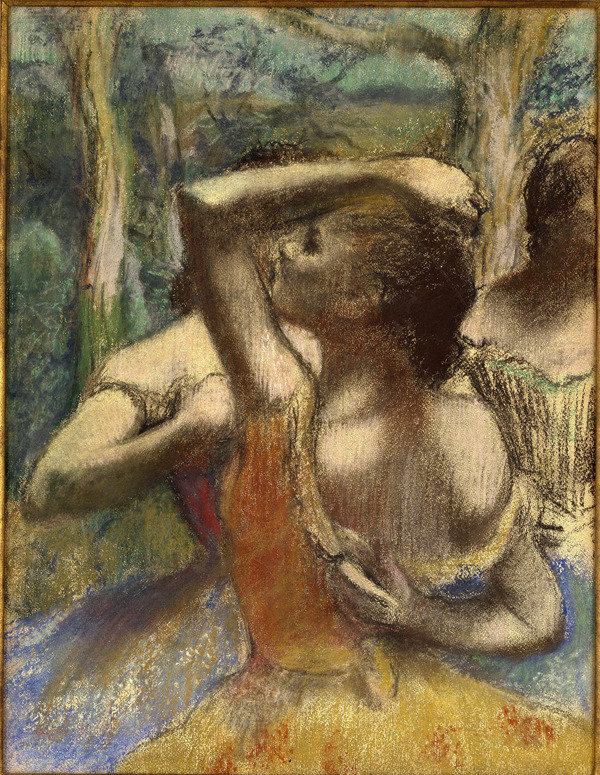Ordinary People by Extraordinary Artists
dal 18/9/2014 al 28/3/2015
Segnalato da
18/9/2014
Ordinary People by Extraordinary Artists
Detroit Institute of Arts, Detroit
Works on Paper by Degas, Renoir, and Friends. Ordinary People is a "who's who" of the most important artists of the late 19th century and the exhibition illustrates their impact on the course art would take moving into the modern era through a focus on their images of people.

(Detroit)—Many of the most popular impressionist-era artists are featured in the Detroit Institute of Arts (DIA) exhibition Ordinary People by Extraordinary Artists: Works on Paper by Degas, Renoir, and Friends, on view September 19, 2014–March 29, 2015. The exhibition is free with museum admission and free for residents of Wayne, Oakland and Macomb counties.
This exhibition is organized by the Detroit Institute of Arts. Support has been provided by the DIA’s Women’s Committee.
Ordinary People is a “who’s who” of the most important artists of the late 19th century and the exhibition illustrates their impact on the course art would take moving into the modern era through a focus on their images of people.
Many of the DIA’s strongest holdings in works on paper are highlighted, including pastels, etchings and lithographs of Edgar Degas’ bathers, dancers and jockeys; Pierre-Auguste Renoir’s portraits of his family and celebrities; Henri de Toulouse-Lautrec’s stage performers; Paul Cézanne’s bathers; and Pierre Bonnard’s and Édouard Vuillard’s intimate interior and city life scenes. Among the other artists featured are Édouard Manet, Paul Gauguin, Georges Seurat, Mary Cassatt and Camille Pissarro.
In 1870s Paris, these young, well-educated and under-appreciated artists radically broke with tradition. Instead of glorifying kings and princes they focused on everyday life and the people around them. Their sketchy style was too unfinished for traditionalists, and officials at the Academy of Fine Arts in Paris dismissed their unconventional ideas as laughable. For their first exhibition, they called themselves the Anonymous Society of Artists; some of the unknowns among them were Degas, Renoir and Cézanne.
While these artists were accomplished painters, printmaking was important to them because they wanted their art to be available to the general public. Prints were usually affordable, and multiple copies could be made, making art accessible to a broad audience, not just for the rich or on museum walls. The public could also enjoy prints through posters and magazines, made especially popular by Toulouse-Lautrec and Bonnard.
Below are details on just three of the artists in the exhibition: Degas, Renoir and Cézanne.
Edgar Degas
Although he had a first-class academic art education, Degas was rarely interested in being conventional. He was the most well-rounded artist of his generation, creating paintings, sculptures, drawings, prints and photographs, all with the intent of working in a new way.
Rather than portraying likenesses or identities, Degas captured expressions of movement and fleeting moments. His bathers appear unposed, as if caught in an awkward moment, and rather than idealizing their bodies, they look real, not perfect. He depicts ballet dancers not as elite divas, but as hard-working professionals engaging in behind-the scene activities—lacing up shoes, stretching or relaxing.
Pierre-Auguste Renoir
Renoir had a long and varied career in painting, sculpting and drawing before discovering printmaking in his 50s. He is best known for his pictures of people—his children, friends, models and famous individuals. He sought to convey a personal side of each of his subjects and, even in his works of celebrities, focused on personalities, not public personas.
For Renoir, making a portrait was not limited to recording a person’s likeness for posterity—he believed photography could do that. Instead, he wanted to convey impressions of warmth and intimacy.
Paul Cézanne
Cézanne was one of the original radical Parisian artists who questioned the rigid ways of the academic art world. Unlike the very precise and smoothly finished images traditional art collectors favored, his bathers are not symbols of beauty, his picture surfaces are not smooth, his brush strokes choppy and his color is patchy. Cézanne was concerned with perspective and making images that expressed his personal vision rather than making images having the realism of a photograph.
Cézanne was always admired by his peers for the way he composed his scenes and created webs of precise strokes—whether with a brush, pencil, crayon or pen. His representations of people are not highly detailed descriptions; they are characterizations suggestive of a face or personality.
The artists in Ordinary People would become some of the most famous in the world, known as the impressionists and post-impressionists. They were extraordinary because their art asked people to see the world a bit differently. What started as a classic struggle of young, radical artists in conflict with the established order quickly became one of the most successful and influential art movements—impressionism. Their work opened up new possibilities for the next generation of artists.
The Detroit Institute of Arts (DIA), one of the premier art museums in the United States, is home to more than 60,000 works that comprise a multicultural survey of human creativity from ancient times through the 21st century. From the first Van Gogh painting to enter a U.S. museum (Self-Portrait, 1887), to Diego Rivera's world-renowned Detroit Industry murals (1932–33), the DIA’s collection is known for its quality, range and depth. The DIA’s mission is to create opportunities for all visitors to find personal meaning in art.
Programs are made possible with support from residents of Wayne, Oakland and Macomb counties.
Image: Dancers, Edgar Degas, about 1897, pastel and charcoal. Detroit Institute of Arts
Press contact
Pamela Marcil
pmarcil@dia.org
313.833.7899
Detroit Institute of Arts
5200 Woodward Avenue, Detroit, Michigan 48202
Museum Hours and Admission
9 a.m.–4 p.m. Tuesdays–Thursdays, 9 a.m.–10 p.m. Fridays, 10 a.m.–5 p.m. Saturdays and Sundays. General admission (excludes ticketed exhibitions) is free for Wayne, Oakland and Macomb county residents and DIA members. For all others, $8 for adults, $6 for seniors ages 62+, $4 for ages 6–17. For membership information, call 313-833-7971.



